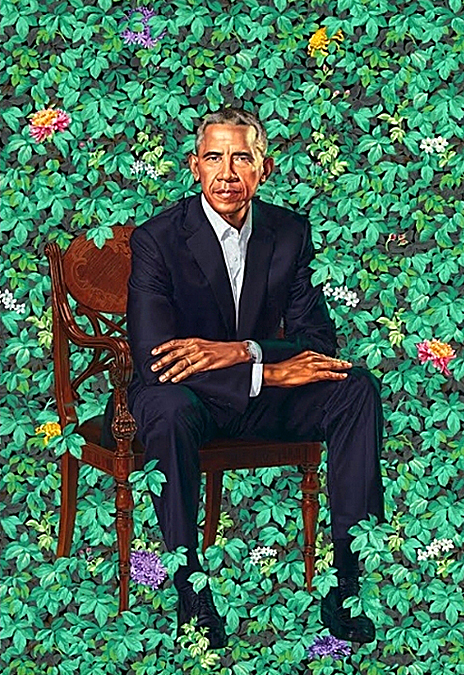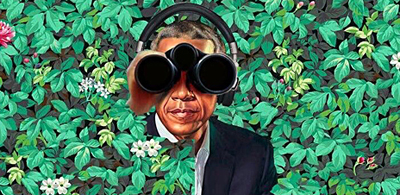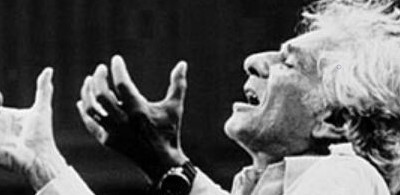Picturing the Obamas and Kehinde Wiley
I can’t recall such an unending fuss about a presidential portrait. The hoopla at the 2018 unveiling of the portraits of former President Barack Obama and First Lady Michelle Obama at the Smithsonian’s National Portrait Gallery was fairly understandable, but then came the media blitz.
Every magazine and paper in the US celebrated the portraits. Likewise “The Obama Portraits Tour” visited eight US art museums from June 2021 to October 2022. That tour was accompanied by The Obama Portraits book. Now we have the Picturing the Obamas documentary. Enough already.
The Smithsonian Channel™ premiered the Picturing the Obamas documentary on Sept. 10, 2022. It focused on the portraits of former President Obama and the First Lady that hang in the National Portrait Gallery, the artists who painted them—Kehinde Wiley and Amy Sherald (respectively), and the public’s reaction to the portraits. When announcing the broadcast, the Smithsonian noted that the paintings “disrupt traditional presidential portraiture.”

While I agree with the distinguished institution’s assertion that the paintings are disruptive, my ideas as to why are different from the Smithsonian’s. Since the portraits were officially unveiled in 2018 at the National Portrait Gallery I have wanted to comment on them, now I’ll do just that. My essay focuses on Mr Wiley and not Ms Sherald, sorry, but there’s only so much love to go around. I will only say that Sherald’s painting of Michelle bore little resemblance to the sitter.
It was only a few years ago that the acolytes of postmodern art were insisting “painting is dead.” The postmodernist disciples proselytized that authenticity, cognition, and intellection could not be found in painting, but only realized in conceptual art, performance art, installation art, video art, land art, identity art, and the other sects of the postmodern congregation.
Kitsch was King and suddenly High art found itself a pauper. Artistic skill was said to be passé, beauty was a social construct, ironic and ugly works were cherished, and appropriation art—or what the rationally minded called plagiarism, was meet with acclaim. Into this morass strode Wiley, and he found himself instantly celebrated.
The director of the Smithsonian’s National Portrait Gallery Kim Sajet (pronounced Say-et), wrote an obsequious article for the February 2019 edition of The Atlantic titled The Obama Portraits Have Had a Pilgrimage Effect. She asserted that the flocks of devotees coming to see the Obama portraits at the museum comprise “a form of secular pilgrimage.” Keep in mind that Ms. Sajet considered this a positive.
Sajet actually equated the Obama “pilgrimage” to the Hajj, the annual journey to Saudi Arabia’s city of Mecca that every good Muslim must do at least once in their life. She claimed the museum had been transformed into “a communal gathering place,” and compared those traveling to see the Obama paintings with Elvis Presley fans traveling to Graceland. Now there’s a vision… a velvet painting of “Great Leader” Obama Presley.
Ms. Sajet is the first woman to serve as the director of the Smithsonian National Portrait Gallery, America’s repository of artworks focusing on famous American politicians, performers, scientists, artists, and other American notables. Her bio on the National Portrait Gallery website states that since she was “born in Nigeria, raised in Australia, and a citizen of the Netherlands,” she “brings a global perspective to the position.” It comes as no surprise that her bio says her interests include “identity politics.”
I have loved and respected a number of Black American artists in my life but Kehinde Wiley is not one of them. I view him as an unmitigated fraud. I have multiple reasons for thinking him a charlatan, but my primary critique is that “assistants” help paint his works.
New York Magazine let the cat out of the bag in its April 20, 2012 article, Kehinde Wiley’s Global Reach. The piece was ingratiating towards Wiley but writer Christopher Beam did expose one embarrassing detail. Beam visited Wiley’s Beijing, China studio, where the artist admitted that he moved there in 2006 to set up his first “global production outpost” where low-wage Chinese “helpers” painted his works. An article excerpt reads:
“There’s nothing new about artists using assistants—everyone from Michelangelo to Jeff Koons has employed teams of helpers, with varying degrees of irony and pride—but Wiley gets uncomfortable discussing the subject. ‘I’m sensitive to it,’ he says. When I first arrived at his Beijing studio, the assistants had left, and he made me delete the iPhone snapshots I’d taken of the empty space.
It’s not that he wants people to believe every brushstroke is his, he says. That they aren’t is public knowledge. It’s just a question of boundaries. ‘I don’t want you to know every aspect of where my hand starts and ends, or how many layers go underneath the skin, or how I got that glow to happen,’ he says. ‘It’s the secret sauce! Get out of my kitchen!’”
Wiley’s “secret sauce” is the exploitation of Chinese labor. The Chinese Communist Party controls all art in China (just ask Ai Weiwei). The CCP knows full well that Wiley is employing Chinese artists, it could not be otherwise as the communists maintain an iron grip on all economic activity, not to mention they run one the most advanced surveillance states in the world today. Wiley’s kitchen euphemism is better replaced with, “If you can’t stand the heat, get out of the kitchen.”
Beam’s article did contain a rather large misstatement. He said of Wiley using helpers to produce his paintings, “It’s not that he wants people to believe every brushstroke is his, that they aren’t is public knowledge.” That statement is just not true.
Aside from Beam’s article in New York Magazine, which radio stations, television broadcasts, newspapers, or magazines have reported that Kehinde Wiley uses assistants to paint his canvases? Has the Smithsonian mentioned this fact? Do the crowds fawning over Wiley’s portrait of Obama know this? Does Barack know?! People erroneously believe that Wily paints every brushstroke.
Speaking as an artist, I would be ashamed to pay others to paint my canvases. Every brushstroke is mine. When the Smithsonian approvingly proclaims that Wiley’s Obama portrait is meant to “disrupt traditional presidential portraiture,” that is why you hear cynical laughter coming from my art studio.
It was also guff for Beam to say, “there’s nothing new about artists using assistants—everyone from Michelangelo to Jeff Koons has employed teams of helpers.” Michelangelo needed the help of assistants to paint his murals at the Sistine Chapel because it was a gargantuan task beyond the abilities of one man. Michelangelo’s hand and vision made those murals and no one ever doubted the fact. Whereas Jeff Koons creates nothing, his projects are entirely fashioned by paid assistants, and his only skill is self-promotion. It was rubbish to compare Michelangelo to Koons.
Mr. Beam stated in his article: “Producing work in China cuts costs, but not as much as it used to, Wiley says. These days in Beijing he employs anywhere from four to ten workers, depending on the urgency.” Beam also revealed that Wiley runs “several global production outposts” but only Beijing, Dakar, and New York City were named. Where are the other “global production outposts” where low-wage drones create Kehinde Wiley’s “original” paintings?
The soft-spoken Kehinde Wiley has the same outlook as Sanford Biggers, another Black American artist consumed by identity politics. Both have given themselves the mission of demolishing the “White supremacist” art world and work to interrupt and mitigate the “Whiteness” of Western art.
As a matter of fact on May 11, 2021 the Smithsonian Magazine wrote an article favorable to Biggers titled: “This Monumental ‘Oracle’ Statue in NYC Subverts Traditional Sculpture,” with a subhead insisting the Biggers’ installation “challenges the tropes of classical artwork.” Such “challenges” are a prerequisite for entrée into elite art circles these days. The article was so full of hypocrisy, contradictions, and inaccuracies that I was compelled to write a takedown of Biggers titled, Sanford Biggers Is Not An Oracle.
Wiley hopes to extirpate the sins of racism and sexism that he sees in Western art by painting “subversive” parodies of classical Western works and themes. Reimagining Old Master paintings is Wiley’s schtick. I loath the postmodern concept of reimagining everything in the Western world. The Old Masters don’t need to be reimagined, they just need to be appreciated for what they were.
Wiley’s conundrum is that his paintings are produced à la Photoshop and sweatshop, and his “subversion” reeks of racialism. One only needs to examine his horrid Judith and Holofernes paintings to see that.
I’m serious when I say Wiley’s paintings are the result of Photoshop. As a wave of criticism began over his Obama portrait, an anonymous person distributed on the internet a diagram examining the painting. With a series of colorful boxes outlining specific areas of the background, the graphic revealed that the foliage behind Obama was repeated again and again. I don’t mean a loose, casual repetition but an exacting, precise duplication of every leaf in a bunch—reduplicated over and over.

Anyone familiar with the Adobe Photoshop graphics application knows of its “rubber stamp” tool, which can fully replicate imagery with the click of a mouse, no drawing skills required. At first glance one doesn’t notice the repetitive duplication in Wiley’s painting, but once you see it you’ll always see it. It’s obvious that a “study” done in Photoshop was projected onto canvas and then traced in pencil. I’m presuming the “help” had the unenviable task of painting in all those blasted leaves.
Admirers of Kehinde Wiley’s Obama portrait always point to the background flower motif as holding profound significance. The purple African lily embodies his fathers’s Kenyan bloodline; the white jasmine personifies his Hawaiian birthplace, and the multicolored chrysanthemum symbolizes Chicago, where he became a State senator. How fitting those flowers were rubber stamped into existence by Photoshop.
Aside from the photoshopped flowers there is another oddity in Kehinde Wiley’s painting. Artists interested in realism must acquire and master basic drawing techniques that create the illusion of space, perspective, and depth on a flat surface; apparently Wiley missed those lessons.
In Wiley’s portrait Obama sits on a chair with its four legs disappearing into the foliage, sprigs of which overlap the backrest and seat. The chair has weight and one imagines its legs firmly planted on the ground, except… Obama’s feet are floating, there is no ground beneath them, they touch nothing. The foliage is suddenly a flat backdrop with no relationship to the foreground. This isn’t another one of Wiley’s “subversive” deconstructions, it’s not any kind of artistic statement—it’s simply his ineptitude as an artist.
This photoshopping of a presidential portrait meant to hang in the Smithsonian’s grand National Portrait Gallery, this imbecilic ignoring of perspective, indicates how far the once glorious art of painting has fallen. But it also points to the moribund state of art criticism and the news media, professions you might think would have an interest in investigating such an affront. “Disrupt traditional presidential portraiture” indeed.
Ben Davis, art critic for Artnet News, offered a very mild critique of Wiley’s Obama portrait in a Feb. 2018 article titled Here’s the Bad News About Kehinde Wiley’s Presidential Portrait of Barack Obama. In his essay Mr Davis heaped praise upon Obama and Wiley, and aimed jabs at then President Trump.
Davis analyzed the mythos presented in the official oil portraits made of Thomas Jefferson (painted by Gilbert Stuart, 1805), George Washington (Gilbert Stuart, 1796), and George W. Bush (Robert Anderson 2008). What Davis wrote about John Singer Sargent’s official 1903 White House portrait of President Teddy Roosevelt I found most revealing:
“In my opinion, this is the most stylish of all presidential portraits. Its savvy artistic myth-making, however, only half distracts me from the small historical fact that Teddy Roosevelt was a ruthless imperialist.”
Davis didn’t call Obama “a ruthless imperialist” despite the 44th President sending 30,000 US combat troops to Afghanistan in 2009. In 2011 Obama launched a war against Libya without a Congressional declaration of war; he didn’t even call it war, he called it “kinetic military action.” The war obliterated Libya, its economy, government, army, and its dictator Muammar Gaddafi. Al-Qaeda raised its flag over Benghazi, ISIS set up operations in the country, and slave markets began selling 1000s of Africans into slavery. Today Libya is still ungovernable… but I digress.

Whatever one might think of the “ruthless imperialist” Teddy Roosevelt, he did offer the following words of wisdom: “To announce that there must be no criticism of the President, or that we are to stand by the President, right or wrong, is not only unpatriotic and servile, but is morally treasonable to the American public.” Those on the Obama pilgrimage should take head of Teddy’s pronouncement, which also applies to the current resident in the White House.
At the end of his article Davis finally got to the Bad News about Obama, while still pummeling Trump: “Obama not only presided over the rise of drone warfare, but the extrajudicial killing of US citizens and the limitless extension of the NSA’s digital surveillance program—all precedents he passed on to his maniacal successor. When that became a crisis after the Snowden leaks, Obama enacted a shock-and-awe crackdown on whistleblowers, invoking the Espionage Act more than all previous administrations combined.”
Art critic Ben Davis barely touched upon Obama’s surveillance program run by the National Security Agency. Without warrants the NSA vacuumed up the emails and phone calls of every American with a phone or computer. But Obama’s NSA didn’t just spy on US citizens, it was also spying on French and German citizens. The NSA spied on 35 world leaders, and Obama personally approved spying on German chancellor Angela Merkel.
The Obama Department of Justice spied on more than 100 staffers of the Associated Press, eavesdropping on their cell, office, and home lines. Imagine if Trump had spied on the AP. Obama even tapped the AP line at the US House of Representatives. But the secretive, cloak-and-dagger activities of Mr. Hope and Change did not go unnoticed by the public.

Kehinde Wiley’s Obama portrait was transformed into dozens of uproarious and politically pointed memes. My favorite was super-sleuth Barack gazing at you through binoculars while partially hidden in the foliage of African lilies, white jasmine, and chrysanthemums.
Davis closed his article with this: “Somewhere, deep down, on the level of subtext and unintended meanings, this strange, strange political portrait ends up being about how the man must be abstracted from the nitty-gritty of his legacy to become the symbol that his followers desire him to be.” So we end as we began, with public desires and how they are manufactured and manipulated.
There’s no space between Duchamp’s The Fountain (a urinal exhibited in 1917), and Tracey Emin’s 1998 My Bed (an unmade bed covered with dirty clothes, cigarette butts, empty alcohol bottles, condoms, and the detritus of Emin’s life). In the postmodern way Emin conjured up a vague semblance of life, a simulacrum.
But Kehinde Wiley himself has become the simulacrum, a representation of an artist whose sole mission is redefining Western canon by way of plagiarism and identity art.
Wiley’s Obama is pure kitsch. I have no idea if low-wage Chinese workers labored on the painting, that’s Wiley’s “secret sauce.” But I’ll take John Singer Sargent’s Teddy Roosevelt portrait any old day.



